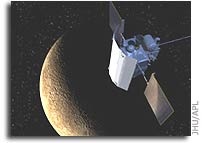NASA MESSENGER Mission News July 9, 2004

MESSENGER is nearly ready to head to the launch pad. Last week the
engineering team loaded propellant – the fuel and oxidizer needed
for MESSENGER’s thrusters – into the spacecraft. This week’s
Webcam image shows the team loading the oxidizer (nitrogen tetroxide);
a few days later they loaded the hydrazine fuel.
When the oxidizer and fuel mix they spontaneously combust,
eliminating the need for any complicated spark mechanism on the
spacecraft. The volatile nature of these materials and their high
toxicity necessitates extreme care; here the MESSENGER team members
wear special anti-contamination suits to ensure their safety. These
suits are sealed and have their own air supply.
Each of MESSENGER’s three main tanks – 22 inches in diameter and
41 inches long – can hold up to 53 gallons of propellant. As with all
spacecraft components mass is at a premium, so the custom-designed
tanks are made of lightweight-yet-strong titanium. In some places,
the tanks’ walls are just 0.02 inches thick.
At launch the spacecraft will have approximately 97 gallons of
hydrazine – with about 47 gallons in two of the main propellant
tanks and just less than 3 gallons in an auxiliary tank. The third
main tank holds about 42 gallons of oxidizer. And the next time you
think you’re being pinched at the pumps of your local gas
station, consider this: a gallon of nitrogen tetroxide costs $224,
while the same amount of hydrazine costs $630.








